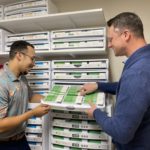
Dr. Foster (right) with his practice’s newest associate, Eriq Hall, OD. Dr. Foster says that getting to the root of discomfort is a key to keeping patients in their contact lenses. The root of that discomfort is often dry eye disease.
By Shane Foster, OD
Dec. 7, 2022
Keeping patients in contact lenses long term results in satisfied, loyal patients and greater practice profitability. The ability to keep patients in their lenses sometimes requires getting to the root of discomfort, and in the process, providing additional care to patients and growing profitability even further.
Here’s the approach our practice takes to keep patients comfortable, and their eyes healthy, so they can stay in contact lenses for as many years as they like.
Getting to the Root Cause of Most Dropouts: Discomfort
Research by Andrew Pucker and Anna A Tichenor found that the overwhelming cause of contact lens dropout is discomfort. They also found that the leading cause of dropout in new wearers is poor vision. As I’ve often jokingly remarked to my patients during a contact lens fit, “What? You want them to be comfortable AND be able to see?” I use humor to let patients know that a contact lens fit or refit is a process, and it may take a few tweaks here and there to get the perfect match that provides excellent vision and comfort.
However, when it comes to patients with specialized vision needs, or those with existing ocular surface disease, we know a little more work is required. Our patients’ eyes are under more strain than ever before, with hours of screen time and dynamically changing visual stimuli now the norm.
Fortunately, with the rapidly growing list of contact lens materials and designs available, we should be able to keep even the most discriminating patient happy in their contact lenses. These are three ways to help keep your contact lens patients satisfied and avoid dropouts:
Manage Dry Eye Syndrome
Since discomfort and dry eye symptoms are among the main reasons patients cite for discontinuing contact lens wear, it is important to appropriately diagnose and manage any underlying dry eye and ocular surface disease in your patients.
Staff is crucial in effectively implementing dry eye management in your practice. Technicians and/or scribes can be easily trained to take a patient history and administer dry eye questionnaires (SPEED, DEQ, OSDI, etc), which are important in diagnosing patient symptoms. Technicians can also be trained to perform many other diagnostic clinical tests, like InflammaDry, TearLab, NIKBUT, meibography, etc.
It is simple to add a few questions to your patient history to probe for dry eye symptoms and to administer standardized questionnaires when indicated. If dry eye disease is suspected, you may choose to do additional tests, such as lissamine green staining, fluorescein staining, tear break-up time and closer inspection of the eyelids and meibomian glands. Once the symptoms and clinical signs have been evaluated, it is necessary to educate the patient on their condition and the proper ways to manage it. Once again, staff can be extremely helpful in this task. When properly trained and empowered, staff can take the lead on patient education about their condition and instruction on management protocols. This frees up the doctor to move on to the next patient or to focus on administrative tasks.
Most providers can implement inexpensive diagnostic tools like questionnaires and vital dyes with little time or financial investment. You can also focus on treatment options that do not require investment from the practice, like prescription or over-the-counter treatments and supplements.
Other Articles to Explore
However, some practitioners may opt to incorporate more advanced technologies in diagnosis and treatment, which may require significant outlay of capital. Tools like the Oculus Keratograph 5M, the Marco Phoenix Meibography Workstation, or the Johnson & Johnson TearScience Lipiview II, will cost your practice tens of thousands of dollars, but will allow you to perform tests that can be billed to the patient and/or managed care plans to help you better diagnose and classify dry eye in your patient population.
Treatment options such as intense pulse light (IPL), low-level light therapy (LLLT) and meibomian gland expression aid patients and offer another revenue stream for your practice (both billable and non-billable), but will incur thousands to tens of thousands of dollars in implementation cost. Each practice has to examine their own financials and patient demographics to make an appropriate decision on which technology to incorporate.
After implementing the Oculus Keratograph 5M and the Vision Source Dry Eye Protocol in our practice, we saw a 16.5 percent growth in sales of dry eye products and over 300 percent increase in revenue for anterior segment imaging (CPT 92285). This alone added over $5,000 of annual revenue to the practice, not to mention that this increased our Evaluation and Management (E&M) revenue and likely saved many contact lens wearers from dropping out of their lenses.
Prescribe Daily Disposable CLs Whenever Possible
Daily disposable options often prove to be more comfortable and more convenient for patients, so this modality greatly improves compliance with wear schedule and keeps patients happy.
The first step in converting your practice to a daily disposable-centered practice is for all practitioners to wear them and really believe in their benefits. Make a commitment that all doctors will reach for a daily disposable as the first lens selection when clinically appropriate. When all the doctors are in agreement, it is time to educate your staff. When we made the concerted effort to change our prescribing habits in our office, we refit all staff members into daily disposable lenses so they could personally experience the comfort and convenience of this modality.
Once the entire office team is on board, it is easy to present this lens option to your patients. I like to tell my patients, “Daily disposable contact lenses are the cleanest, safest and healthiest option for your eyes,” and then go on to say, “In most cases, patients also find them to be more comfortable and very convenient.”
Patients are generally amenable to this discussion and agree that daily disposables sound like a great option, but you can probably guess their next question: “How much is that going to cost?” It’s true, daily disposable lenses are more expensive than monthly or two-week replacement lenses.
For that reason, we always try to point out all the additional benefits that patients can gain by switching to a daily disposable lens. We found it helpful to break down the fees into a cost per day. (You can go a step further and compare that to the cost of a daily Starbucks order). We also pointed out that the patient no longer needs to purchase contact lens solutions. That also helps bring down the net cost over the course of a year.
Switching to daily disposable lenses not only offers the patient a more comfortable and convenient contact lens option, but it also allows for flexibility in wear schedule. With the changes in work schedules since the COVID-19 pandemic, I have noticed that many of my patients have changed their contact lens wear habits as well. The widespread use of face masks brought many more patients to my chair interested in trying contact lenses for the first time, but also brought many long-time contact lens wearers in for an updated pair of glasses because their work-from-home schedules found them wearing their spectacles more frequently.
Whatever the reason may be, daily disposable lenses offer a great option for patients who choose part-time wear because they do not have to worry about how long a pair of lenses may have been sitting in solution in a case. They can get a fresh, clean pair of lenses each time.
Utilize Full Range of Modern CL Technologies like Multifocals & Toric Multifocals
Most contact lens patients becoming presbyopic today may have been wearing contact lenses for 25-30 years. They are young and active and want to continue wearing contact lenses for decades to come. If you are not utilizing and offering all the presbyopic contact lens options, then you may experience more patients discontinuing contact lens wear as their near vision demands change.
Contact lens technicians and sales staff need to be educated on any new product options that are being introduced into the practice. It is crucial that staff understand the importance of the new lens offerings and what patients might be good candidates for that technology. You will also need to make sure technicians and scribes understand the methods for acuity-taking (what types of charts, lighting conditions to use, etc) as well as the proper patient education, so patients know what to expect as a new multifocal contact lens wearer.
Most contact lens brands that our patients are already wearing are available in multifocal options. It is generally pretty easy to discuss the transition to a multifocal lens, assuming the patient is enjoying good vision and comfort in their current lenses. It is also a great opportunity to transition your patients to a different lens brand or material if they are experiencing any lens awareness, dryness or other discomfort. It’s great when you can improve the patient’s vision AND comfort – those patients will actively refer their friends, family and colleagues to your practice.
Multifocal contact lens options most often come at a higher cost of goods for the practice, but this cost is passed on to the patient. You might need to re-evaluate your pricing strategy for contact lens services and materials to make sure you are being adequately compensated for your time and expertise.
To fit the multifocal and toric multifocal lens options from the major manufacturers, all you need is your regular office equipment and the manufacturer-provided fitting guide. They are easy to use and help you arrive at the best diagnostic lens within a few seconds.
Whether you’re an expert or a novice when it comes to multifocal fitting, always start the process by following the fitting guide. The contact lens companies spend a lot of time researching and developing those guides to aid the practitioners and help ensure a successful fit.
Bottom Line
By implementing any of these changes in your practice, you will find an increase in your contact lens patients’ satisfaction and keep those smiling faces coming back to you year after year. Even more rewarding, those happy patients will tell many others about the extra steps you take in your practice to achieve a successful contact lens fit.
 By Shane Foster, OD, is the owner of Athens Eye Care in Athens, Ohio, and Hocking Hills Eye Care in Logan, Ohio, which was named one of CooperVision’s Best Practices. To contact Dr. Foster: shanefosterod@gmail.com
By Shane Foster, OD, is the owner of Athens Eye Care in Athens, Ohio, and Hocking Hills Eye Care in Logan, Ohio, which was named one of CooperVision’s Best Practices. To contact Dr. Foster: shanefosterod@gmail.com

























